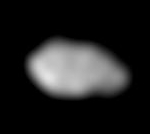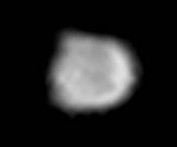Metis (moon)
 Image of Metis was taken by Galileo's solid state imaging system between November 1996 and June 1997. | |
| Discovery | |
|---|---|
| Discovered by | S. Synnott |
| Discovery date | March 4, 1979 |
| Orbital characteristics | |
| Periapsis | 127,974 km[a] |
| Apoapsis | 128,026 km[a] |
Mean orbit radius | 128,000 km (1.792 RJ)[1][2] |
| Eccentricity | 0.0002[1][2] |
| 0.294780 d (7 h 4.5 min)[1][2] | |
Average orbital speed | 31.501 km/s[a] |
| Inclination | 0.06° (to Jupiter's equator)[1][2] |
| Satellite of | Jupiter |
| Physical characteristics | |
| Dimensions | 60×40×34 km³[3] |
| 21.5 ± 2.0 km[3] | |
| Volume | ~42,700 km³ |
| Mass | 3.6 ×1016 kg[a] |
Mean density | 0.86 g/cm³ (assumed) |
| 0.005 m/s² (0.0005 g)[a] | |
| 0.012 km/s[a] | |
| synchronous | |
| zero[3] | |
| Albedo | 0.061 ± 0.003[4] |
| Temperature | ~123 K |

Metis (/[invalid input: 'icon']ˈmiːt[invalid input: 'ɨ']s/ MEE-təs; Template:Lang-el), also known as Jupiter XVI, is the innermost moon of Jupiter. It was discovered in 1979 in images taken by Voyager 1, and was named in 1983 after the first wife of Zeus, Metis. Additional observations made between early 1996 and September 2003 by the Galileo spacecraft allowed the surface of the moon to be imaged.
Metis is tidally locked to Jupiter, which led[citation needed] to a high asymmetry in the shape of the moon, with one of the diameters being almost twice as large as the smallest one. It is also one of the three moons in the Solar System known to orbit its planet in less than the length of that planet's day, the other two being Jupiter's Adrastea and Mars's Phobos. It orbits within the main ring of Jupiter, and is thought to be a major contributor of material to the rings.
Discovery and observations
Metis was discovered in 1979 by Stephen P. Synnott in images taken by the Voyager 1 probe and was provisionally designated as S/1979 J 3.[5][6] In 1983 it was officially named after the mythological Metis, a Titaness who was the first wife of Zeus (the Greek equivalent of Jupiter).[7] The photographs taken by Voyager 1 showed Metis only as a dot, and hence knowledge about Metis was very limited until the arrival of the Galileo spacecraft. Galileo imaged almost all of the surface of Metis and put constraints on its composition by 1998.[3]
Physical characteristics
Metis has an irregular shape and measures 60×40×34 km across, which makes it the second smallest of the four inner satellites of Jupiter.[3] Therefore, a very rough estimate of its surface area could be placed between 5,800 and 11,600 square kilometers (approx. 8,700). The bulk composition and mass of Metis are not known, but assuming that its mean density is like that of Amalthea (~0.86 g/cm³),[8] its mass can be estimated as ~3.6×1016 kg. This density would imply that it is composed of water ice with a porosity of 10–15%.[8]
The Metidian surface is heavily cratered, dark, and appears to be reddish in color. There is a substantial asymmetry between leading and trailing hemispheres: the leading hemisphere is 1.3-times brighter than the trailing one. The asymmetry is probably caused by the higher velocity and frequency of impacts on the leading hemisphere, which excavate a bright material (presumably ice) from the interior of the moon.[4]
Orbit
Metis is the innermost of Jupiter's four small inner moons. It orbits Jupiter at a distance of ~128,000 km (1.79 Jupiter radii) within the planet's main ring. Its orbit has very small eccentricity (~0.0002) and inclination (~ 0.06°) relative to the equator of Jupiter.[1][2]
Due to tidal locking, Metis rotates synchronously with its orbital period, with its longest axis aligned towards Jupiter.[2][3]
Metis lies inside Jupiter's synchronous orbit radius (as does Adrastea), and as a result, tidal forces slowly cause its orbit to decay, and the moon will eventually impact Jupiter. If its density is similar to Amalthea's, Metis's orbit lies within the fluid Roche limit; however, since it has not broken up, it must lie outside its rigid Roche limit.[2]
Relationship with Jupiter's rings
Metis's orbit lies ~1000 km within the main ring of Jupiter. It orbits within a ~500 km wide "gap" or "notch" in the ring.[2][9] The gap is clearly somehow related to the moon but the origin of this connection has not been established. Metis supplies a significant part of the main ring’s dust.[10] This material appears to consist primarily of material that is ejected from the surfaces of Jupiter's four small inner satellites by meteorite impacts. It is easy for the impact ejecta to be lost from the satellites into space because the satellites' surfaces lie fairly close to the edge of their Roche spheres due to their low density.[2]
See also
References
- ^ a b c d e Evans Porco et al. 2002.
- ^ a b c d e f g h i Burns Simonelli et al. 2004.
- ^ a b c d e f Thomas Burns et al. 1998.
- ^ a b Simonelli Rossier et al. 2000.
- ^ IAUC 3507.
- ^ Synnott 1981.
- ^ IAUC 3872.
- ^ a b Anderson Johnson et al. 2005.
- ^ Ockert-Bell Burns et al. 1999.
- ^ Burns Showalter et al. 1999.
Cited sources
- Attention: This template ({{cite doi}}) is deprecated. To cite the publication identified by doi: 10.1126/science.1110422 , please use {{cite journal}} (if it was published in a bona fide academic journal, otherwise {{cite report}} with
|doi= 10.1126/science.1110422instead. - Attention: This template ({{cite doi}}) is deprecated. To cite the publication identified by doi: 10.1126/science.284.5417.1146 , please use {{cite journal}} (if it was published in a bona fide academic journal, otherwise {{cite report}} with
|doi= 10.1126/science.284.5417.1146instead. - Burns, Joseph A.; Simonelli, Damon P.; Showalter, Mark R.; Hamilton, Douglas P.; Porco, Carolyn C.; Throop, Henry; Esposito, Larry W. (2004). "Jupiter's Ring-Moon System" (PDF). In Bagenal, Fran; Dowling, Timothy E.; McKinnon, William B. (eds.). Jupiter: The Planet, Satellites and Magnetosphere. Cambridge University Press. pp. 241–262. Bibcode:2004jpsm.book..241B. ISBN 978-0-521-81808-7.
{{cite encyclopedia}}:|journal=ignored (help) - Evans, M. W.; Porco, C. C.; Hamilton, D. P. (2002). "The Orbits of Metis and Adrastea: The Origin and Significance of their Inclinations". Bulletin of the American Astronomical Society. 34: 883. Bibcode:2002DPS....34.2403E.
{{cite journal}}: Unknown parameter|month=ignored (help) - Marsden, Brian G. (August 26, 1980). "Satellites of Jupiter". IAU Circular. 3507. Retrieved 2012-03-28. (discovery)
- Marsden, Brian G. (September 30, 1983). "Satellites of Jupiter and Saturn". IAU Circular. 3872. Retrieved 2012-03-28. (naming the moon)
- Attention: This template ({{cite doi}}) is deprecated. To cite the publication identified by doi: 10.1006/icar.1998.6072 , please use {{cite journal}} (if it was published in a bona fide academic journal, otherwise {{cite report}} with
|doi= 10.1006/icar.1998.6072instead. - Attention: This template ({{cite doi}}) is deprecated. To cite the publication identified by doi: 10.1006/icar.2000.6474 , please use {{cite journal}} (if it was published in a bona fide academic journal, otherwise {{cite report}} with
|doi= 10.1006/icar.2000.6474instead. - Attention: This template ({{cite doi}}) is deprecated. To cite the publication identified by doi: 10.1126/science.212.4501.1392 , please use {{cite journal}} (if it was published in a bona fide academic journal, otherwise {{cite report}} with
|doi= 10.1126/science.212.4501.1392instead. - Attention: This template ({{cite doi}}) is deprecated. To cite the publication identified by doi: 10.1006/icar.1998.5976 , please use {{cite journal}} (if it was published in a bona fide academic journal, otherwise {{cite report}} with
|doi= 10.1006/icar.1998.5976instead.
External links
